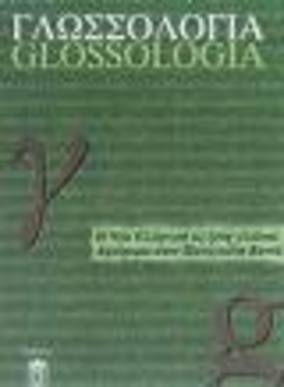Γυναικείοι χαρακτήρες και ταυτότητες στο νεοελληνικό θέατρο
Part of : Γλωσσολογία ; Vol.20, 2012, pages 1-18
Issue:
Pages:
1-18
Abstract:
The aim of this paper is to present how a keyword analysis offers an empirical way of revealing lexical andgrammatical patterns that provide solid evidence for the understanding of the characters in a particular play. Inaddition, such an approach, which contributes to the field of corpus stylistics, can give significant informationabout the emergence of both individual and group identities. Based on positioning theory, the analysis of thestatistically important words reveals how “acts of gender identities” are constructed, not only in comparisonand opposition to the other characters, but also in relation to social and ideological value systems concerningthe relationship of men and women.
Subject:
Subject (LC):
Keywords:
θεατρικός λόγος, θεωρία τοποθέτησης, λέξεις-κλειδιά, ταυτότητες, υφολογία
Notes:
Περιέχει πίνακα και βιβλιογραφία, Η παρούσα έρευνα ολοκληρώθηκε µε πόρους του προγράµµατος: «Κείµενο και ερµηνεία: Ανάλυση και επεξεργασία χειρογράφων, έντυπων και ψηφιακών γλωσσικών πόρων» (2011) του Τµήµατος Φιλολογίας. Θα θέλαµε επίσης να ευχαριστήσουµε θερµά τους συναδέλφους καθηγητές Αργύρη Αρχάκη και Γιώργο Μικρό για τις συζητήσεις που είχαµε µαζί τους στο αρχικό στάδιο της µελέτης αυτής καθώς και για τις εποικοδοµητικές τους παρατηρήσεις και τα σχόλιά τους στο τελικό κείµενο.
References (1):
- Αρχάκης, Α. & Τσάκωνα, Β. 2011. Ταυτότητες, αφηγήσεις και γλωσσική εκπαίδευση. Αθήνα: Πατάκης.Baker, P. 2004. Querying keywords: Questions of difference, frequency and sense in keywordsanalysis. Journal of English Linguistics 32 (4), 346-359.Baker, P. 2006. Using Corpora in Discourse Analysis. London: Continuum.Bondi, M. 2010. Perspectives on keywords and keyness. In M. Bondi & M. Scott (eds), Keyness inTexts. Amsterdam/Philadelphia: John Benjamins, 1-18.Busse, B. 2006. Vocative Constructions in the Language of Shakespeare. Amsterdam/Philadelphia:John Benjamins.Γούτσος, ∆. 2009. Λεξικά συµπλέγµατα και στερεότυπα στο δηµοσιογραφικό λόγο. ΖητήµαταΕπικοινωνίας 9, 75-89.Coates, J. 1996. Women Τalk: Conversation between Women Friends. Oxford: Blackwell.Coates, J. 2003. Men Τalk. Oxford: Blackwell.Culpeper, J. 2002. Computers, language and characterization: An analysis of six characters in Romeoand Juliet. In U. Melander-Marttala, C. Ostman & M. Kytö (eds), Conversation in Life andLiterature: Papers from the ASLA Symposium. Association Suedoise de Linguistique Appliquée(ASLA), 15. Universitetstryckeriet: Uppsala, 11-30.Culpeper, J. 2009. Words, parts-of-speech and semantic categories in the character-talk ofShakespeare’s Romeo and Juliet. International Journal of Corpus Linguistics 14 (1), 29-59.De Fina, A., Schiffrin, D. & Bamberg, M. 2006. Discourse and Identity. Cambridge: CambridgeUniversity Press.Demmen, J. 2009. Charmed and chattering tongues: Investigating the functions and effects of the wordclusters in the dialogue of Shakespeare’s female characters. Unpublished MA dissertation.Lancaster University.Dunning, T. 1993. Accurate methods for the statistics of surprise and coincidence. ComputationalLinguistics 19, 61-74.Groom, N. 2010. Closed-class keywords and corpus-driven discourse analysis. In M. Bondi & M.Scott (eds), Keyness in Τexts. Amsterdam/Philadelphia: John Benjamins, 59-78.Hota, S. R., Argamon, S., Koppel, M. & Zigdon, I. 2006. Performing gender: Automatic stylisticanalysis of Shakespeare's characters. Paper presented at the Proceedings of Digital Humanities2006, Paris.Ιακώβου, Μ., Μαρκόπουλος, Γ. & Μικρός, Γ. Κ. 2003. Θεµατοποιηµένο βασικό λεξιλόγιο µέσωΗΣΚ: Πρακτική εφαρµογή στη διδασκαλία της Νέας Ελληνικής ως Ξένης Γλώσσας. Πρακτικάτου 6ου ∆ιεθνούς Συνεδρίου Ελληνικής Γλωσσολογίας, 18-21 Σεπτεµβρίου 2003, Ρέθυµνο.∆ιαθέσιµο στην ηλεκτρονική διεύθυνση: http://www.philology.uoc.gr/conferences/6thICGL/ebook/a/iakovou&markopoulos&mikros.pdfMahlberg, M. 2007a. Clusters, key clusters and local textual functions in Dickens. Corpora 2 (1), 1-31.Mahlberg, M. 2007b. A corpus stylistic perspective on Dickens’ Great Expectations. In M. Lambrou& P. Stockwell (eds), Contemporary Stylistics. London/New York: Continuum, 19-31.Mikros, G. K. 2006. Authorship attribution in Modern Greek newswire corpora. In O. Uzuner, S.Argamon & J. Karlgren (eds), Proceedings of the SIGIR 2006 International Workshop onDirections in Computational Analysis of Stylistics in Text Retrieval. Seattle, Washington, USA:ACM, 43-47.Mikros, G. K. 2007. Stylometric experiments in Modern Greek: Investigating authorship inhomogeneous newswire texts. In R. Köhler, G. Altmann & P. Grzybek (eds), Exact Methods inthe Study of Language and Text. Berlin/New York: Mouton de Gruyter, 445-456.Murphy, S. 2007. Now I am alone: A corpus stylistic approach to Shakespearian soliloquies. In C.Gabrielatos, R. Slessos & J. Unger (eds), Papers from the Lancaster University PostgraduateConference in Linguistics & Language Teaching. Available at:http://www.ling.lancs.ac.uk/pgconference/v01/Murphy.pdf.Rayson, P. 2003. Matrix: A statistical method and software tool for linguistic analysis through corpuscomparison. Ph.D. Τhesis. Lancaster University.Rayson, P. 2008. From keywords to key semantic domains. International Journal of CorpusLinguistics 13 (4), 519-549.Scott, M. 1997. PC analysis of keywords – and key key words. System 25 (1), 1-13.Scott, M. 1999. WordSmith Tools Version 3.0. Oxford: Oxford University Press.Scott, M. 2000. Focusing on the text and its key words. In L. Burnard & T. Mc Enery (eds),Rethinking Language Pedagogy from a Corpus Perspective: Papers from the ThirdInternational Conference on Teaching and Language Corpora. Frankfurt: Peter Lang, 104-121.Scott, M. & Tribble, C. 2006. Textual Patterns: Key words and Corpus Analysis in LanguageEducation. Amsterdam/Philadelphia: John Benjamins.Semino, E. & Short, M. 2004. Corpus Stylistics. Abingdon/New York: Routledge.Stubbs, M. 2005. Conrad in the computer: Examples of quantitative stylistic methods. Language andLiterature 14 (1), 5-24.Φέρλας, Α. Ε. 2011. Ο προκατασκευασµένος λόγος στα Ελληνικά και Αγγλικά. Μια µελέτηβασισµένη σε σώµατα κειµένων µε προεκτάσεις στη διδασκαλία της γλώσσας. Αδηµοσίευτηδιδακτορική διατριβή. Πανεπιστήµιο Αθηνών.Wortham, S. 2001. Narratives in Action: A Strategy for Research and Analysis. New York: Teachers’College Press.Wynne, M. 2006. Stylistics: Corpus approaches. In K. Brown (ed.), Encyclopedia of Language andLinguistics. 2nd edition. Oxford: Elsevier, Vol. 12, 223-226.




